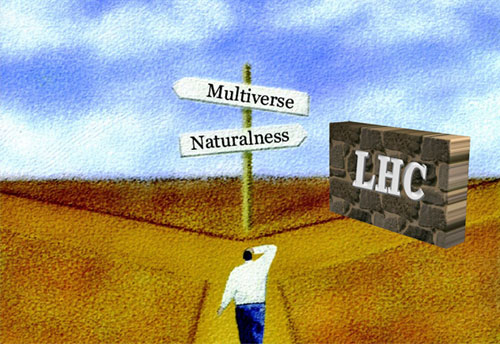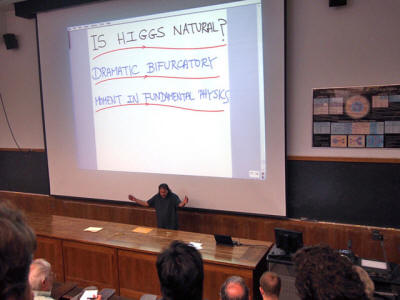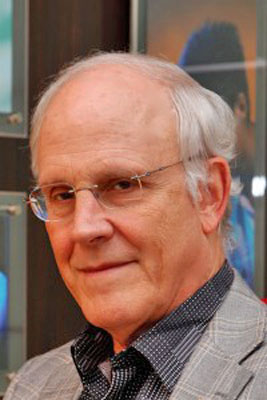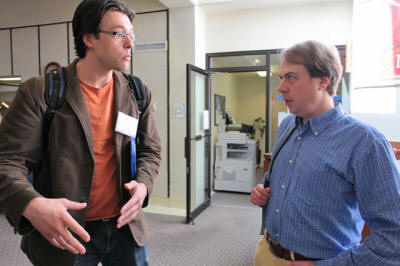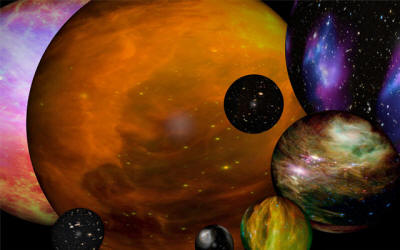|
from SimonsFoundation Website
Decades of Confounding Experiments Have Physicists Considering a Startling Possibility...
The Universe Might Not Make Sense
On an overcast afternoon in late April, physics professors and students crowded into a wood-paneled lecture hall at Columbia University for a talk by Nima Arkani-Hamed, a high-profile theorist visiting from the Institute for Advanced Study in nearby Princeton, N.J.
With his dark, shoulder-length hair shoved behind his ears, Arkani-Hamed laid out the dual, seemingly contradictory implications of recent experimental results at the Large Hadron Collider in Europe.
The spectacular discovery of the Higgs Boson in July 2012 confirmed a nearly 50-year-old theory of how elementary particles acquire mass, which enables them to form big structures such as galaxies and humans.
However, in order for the Higgs Boson to make sense with the mass (or equivalent energy) it was determined to have, the LHC needed to find a swarm of other particles, too.
None turned up.
“The universe is impossible,” said Nima Arkani-Hamed, 41, of the Institute for Advanced Study, during a recent talk at Columbia University. (Photo: Natalie Wolchover/Simons Science News)
With the discovery of only one particle, the LHC experiments deepened a profound problem in physics that had been brewing for decades.
Modern equations seem to capture reality with breathtaking accuracy, correctly predicting the values of many constants of nature and the existence of particles like the Higgs.
Yet a few constants - including the mass of the Higgs Boson - are exponentially different from what these trusted laws indicate they should be, in ways that would rule out any chance of life, unless the universe is shaped by inexplicable fine-tunings and cancellations.
In peril is the notion of “naturalness,” Albert Einstein’s dream that the laws of nature are sublimely beautiful, inevitable and self-contained. Without it, physicists face the harsh prospect that those laws are just an arbitrary, messy outcome of random fluctuations in the fabric of space and time.
The LHC will resume smashing protons in 2015 in a last-ditch search for answers.
But in papers, talks and interviews, Arkani-Hamed and many other top physicists are already confronting the possibility that the universe might be unnatural. (There is wide disagreement, however, about what it would take to prove it.)
“There are frustrating theoretical problems in quantum field theory that demand solutions, but the string theory ‘landscape’ of 10500 solutions does not make sense to me. Neither does the multiverse concept or the anthropic principle,” said David J. Gross, a Nobel Prize-winning physicist. To read the full interview, click here.
Physicists reason that if the universe is unnatural, with extremely unlikely fundamental constants that make life possible, then an enormous number of universes must exist for our improbable case to have been realized.
Otherwise, why should we be so lucky? Unnaturalness would give a huge lift to the multiverse hypothesis, which holds that our universe is one bubble in an infinite and inaccessible foam.
According to a popular but polarizing framework called string theory, the number of possible types of universes that can bubble up in a multiverse is around 10500. In a few of them, chance cancellations would produce the strange constants we observe.
In such a picture, not everything about this universe is inevitable, rendering it unpredictable.
Edward Witten, a string theorist at the Institute, said by email,
What the LHC does or doesn’t discover in its next run is likely to lend support to one of two possibilities: Either we live in an overcomplicated but stand-alone universe, or we inhabit an atypical bubble in a multiverse.
Cosmic Coincidence
Einstein once wrote that for a scientist,
Indeed, throughout the 20th century, the deep-seated belief that the laws of nature are harmonious - a belief in “naturalness” - has proven a reliable guide for discovering truth.
In practice, it is the requirement that the physical constants (particle masses and other fixed properties of the universe) emerge directly from the laws of physics, rather than resulting from improbable cancellations.
Time and again, whenever a constant appeared fine-tuned, as if its initial value had been magically dialed to offset other effects, physicists suspected they were missing something. They would seek and inevitably find some particle or feature that materially dialed the constant, obviating a fine-tuned cancellation.
This time, the self-healing powers of the universe seem to be failing.
The Higgs Boson has a mass of 126 giga-electron-volts, but interactions with the other known particles should add about 10,000,000,000,000,000,000 giga-electron-volts to its mass.
This implies that the Higgs’ “bare mass,” or starting value before other particles affect it, just so happens to be the negative of that astronomical number, resulting in a near-perfect cancellation that leaves just a hint of Higgs behind: 126 giga-electron-volts.
Physicists have gone through three generations of particle accelerators searching for new particles, posited by a theory called supersymmetry, that would drive the Higgs mass down exactly as much as the known particles drive it up.
But so far they’ve come up empty-handed.
The upgraded LHC will explore ever-higher energy scales in its next run, but even if new particles are found, they will almost definitely be too heavy to influence the Higgs mass in quite the right way. The Higgs will still seem at least 10 or 100 times too light.
Physicists disagree about whether this is acceptable in a natural, stand-alone universe.
But in Arkani-Hamed’s opinion, being,
If no new particles appear and the Higgs remains astronomically fine-tuned, then the multiverse hypothesis will stride into the limelight.
Brookhaven Forum 2013 David Curtin, left, a postdoctoral researcher at Stony Brook University, and Alessandro Strumia, a physicist at the National Institute for Nuclear Physics in Italy, discussing Strumia’s “modified naturalness” idea, which questions longstanding assumptions about how to calculate the natural value of the Higgs Boson mass. (Photo: Thomas Lin/Simons Science News)
A few physicists - notably Joe Lykken of Fermi National Accelerator Laboratory in Batavia, Ill., and Alessandro Strumia of the University of Pisa in Italy - see a third option.
They say that physicists might be misgauging the effects of other particles on the Higgs mass and that when calculated differently, its mass appears natural.
This "modified naturalness" (A Modified Naturalness Principle and Its Experimental Tests) falters when additional particles, such as the unknown constituents of dark matter, are included in calculations - but the same unorthodox path could yield other ideas.
However, modified naturalness cannot fix an even bigger naturalness problem that exists in physics:
Dark Dilemma
The energy built into the vacuum of space (known as vacuum energy, dark energy or the cosmological constant) is a baffling trillion trillion trillion trillion trillion trillion trillion trillion trillion trillion times smaller than what is calculated to be its natural, albeit self-destructive, value.
No theory exists about what could naturally fix this gargantuan disparity.
But it’s clear that the cosmological constant has to be enormously fine-tuned to prevent the universe from rapidly exploding or collapsing to a point. It has to be fine-tuned in order for life to have a chance.
To explain this absurd bit of luck, the multiverse idea has been growing mainstream in cosmology circles over the past few decades.
It got a credibility boost in 1987 when the Nobel Prize-winning physicist Steven Weinberg, now a professor at the University of Texas at Austin, calculated that the cosmological constant of our universe is expected in the multiverse scenario (Anthropic Bound on The Cosmological Constant).
Of the possible universes capable of supporting life - the only ones that can be observed and contemplated in the first place - ours is among the least fine-tuned.
Most particle physicists hoped that a more testable explanation for the cosmological constant problem would be found. None has. Now, physicists say, the unnaturalness of the Higgs makes the unnaturalness of the cosmological constant more significant.
Arkani-Hamed thinks the issues may even be related.
The multiverse turned into slightly more than just a hand-waving argument in 2000, when Raphael Bousso and Joe Polchinski, a professor of theoretical physics at the University of California at Santa Barbara, found a mechanism that could give rise to a panorama of parallel universes.
String theory, a hypothetical “theory of everything” that regards particles as invisibly small vibrating lines, posits that space-time is 10-dimensional.
At the human scale, we experience just three dimensions of space and one of time, but string theorists argue that six extra dimensions are tightly knotted at every point in the fabric of our 4-D reality.
Bousso and Polchinski calculated (Quantization of Four-form Fluxes and Dynamical Neutralization of the Cosmological Constant) that there are around 10500 different ways for those six dimensions to be knotted (all tying up varying amounts of energy), making an inconceivably vast and diverse array of universes possible.
In other words, naturalness is not required.
There isn’t a single, inevitable, perfect universe.
But the paper sparked outrage.
Life in a Multiverse
The Big Bang, in the Bousso-Polchinski multiverse scenario, is a fluctuation. A compact, six-dimensional knot that makes up one stitch in the fabric of reality suddenly shape-shifts, releasing energy that forms a bubble of space and time.
The properties of this new universe are determined by chance:
The vast majority of universes that burst into being in this way are thick with vacuum energy; they either expand or collapse so quickly that life cannot arise in them.
But some atypical universes, in which an improbable cancellation yields a tiny value for the cosmological constant, are much like ours.
In the multiverse scenario a vast and diverse array of bubble universes fluctuate into existence inside a larger vacuum. A small fraction of the universes have physical properties conducive to life.
In a paper posted last month to the physics preprint website arXiv.org (Why Comparable? A Multiverse Explanation of the Dark Matter), Bousso and a Berkeley colleague, Lawrence Hall, argue that the Higgs mass makes sense in the multiverse scenario, too.
They found that bubble universes that contain enough visible matter (compared to dark matter) to support life most often have supersymmetric particles beyond the energy range of the LHC, and a fine-tuned Higgs Boson.
Similarly, other physicists showed in 1997 that if the Higgs Boson were five times heavier than it is, this would suppress the formation of atoms other than hydrogen, resulting, by yet another means, in a lifeless universe.
Despite these seemingly successful explanations, many physicists worry that there is little to be gained by adopting the multiverse worldview.
Parallel universes cannot be tested for; worse, an unnatural universe resists understanding.
That sentiment is echoed again and again:
But theories can grow on physicists.
After spending more than a decade acclimating himself to the multiverse, Arkani-Hamed now finds it plausible - and a viable route to understanding the ways of our world.
Naturalness could pull through. Or it could be a false hope in a strange but comfortable pocket of the multiverse.
As Arkani-Hamed told the audience at Columbia, “stay tuned.”
|

